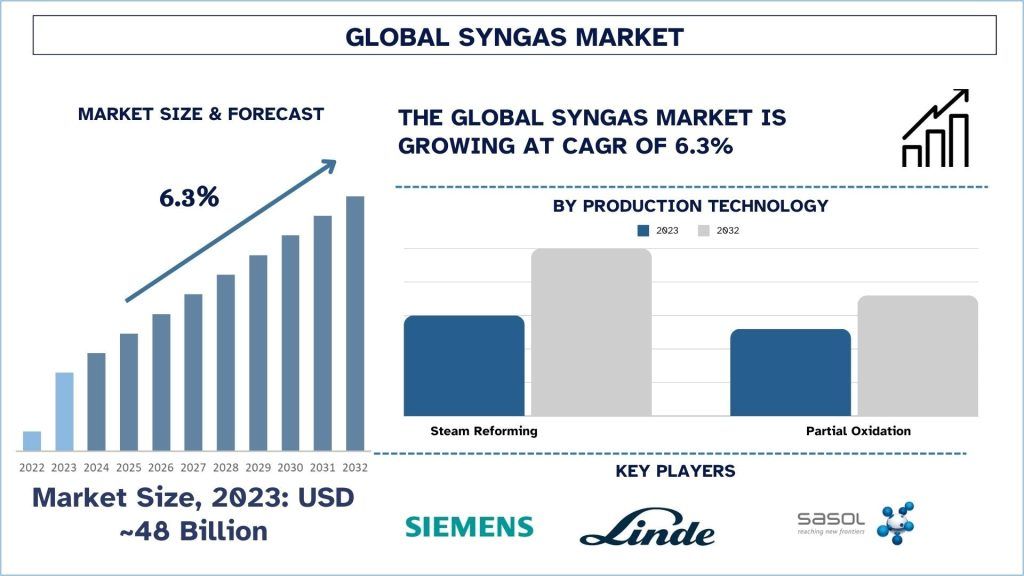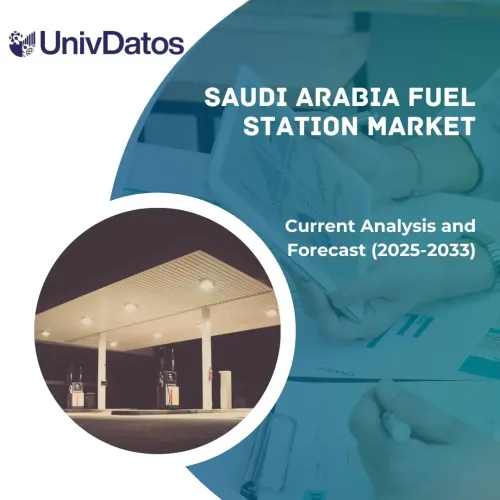- Strona główna
- O nas
- Branża
- Usługi
- Czytanie
- Kontakt
Rynek gazu syntezowego: Aktualna analiza i prognoza (2024-2032)
Nacisk na technologię produkcji (reforming parowy i częściowe utlenianie), surowiec (gaz ziemny, węgiel, biomasa/odpady i inne); Typ gazifikatora (gazogeneratory ze złożem stałym, gazogeneratory z przepływem unoszącym, gazogeneratory ze złożem fluidalnym i inne); Zastosowanie (metanol, amoniak, wodór, paliwa płynne, żelazo zredukowane bezpośrednio, syntetyczny gaz ziemny, energia elektryczna i inne); Region/Kraj
Wielkość i prognoza rynku syngazu
Wartość rynku syngazu wyniosła 48 miliardów USD w 2023 r. i oczekuje się, że w okresie prognozy (2024–2032) będzie rósł w silnym tempie CAGR wynoszącym około 6,3%. Rynek syngazu lub gazu syntezowego rozwija się dzięki różnorodnym zastosowaniom w chemii, produkcji energii elektrycznej, paliwach do pojazdów i innych. Syngaz, będący mieszaniną wodoru, tlenku węgla i dwutlenku węgla, jest zwykle wytwarzany przez zgazowanie substancji węglowych, w tym węgla, biomasy lub gazu ziemnego. Ze względu na jego wszechstronność jako surowca do wytwarzania wielu produktów chemicznych, takich jak metanol, amoniak i syntetyczny gaz ziemny, odgrywa on kluczową rolę w globalnym przemyśle energetycznym i chemicznym.
Kolejnym czynnikiem napędzającym rynek syngazu jest rosnące zaniepokojenie globalnego społeczeństwa wykorzystaniem czystszych źródeł energii. Ze względu na jego zdolność do zapewnienia produkcji czystszych paliw i ograniczenia zużycia konwencjonalnych źródeł paliw, syngaz jest bardzo istotny, ponieważ rządy i przemysły na całym świecie koncentrują się na rozwiązywaniu problemu emisji dwutlenku węgla. Wykorzystanie syngazu w wytwarzaniu energii, szczególnie w elektrowniach gazowo-parowych, wykorzystuje wydajne i przyjazne dla środowiska systemy, co z kolei zwiększa popyt na syngaz.
Analiza rynku syngazu
Na rynku syngazu obserwuje się udoskonalenia w technologiach zgazowania, które zwiększają skuteczność i opłacalność produkcji syngazu. Postęp ten zwiększył możliwość zastosowania syngazu w szerokiej gamie produktów, takich jak zaawansowane biopaliwa i synteza chemiczna. Na przykład, w 2024 roku Siemens AG i Boson Energy zgodziły się przyspieszyć transformację w kierunku zielonej energii poprzez technologię przetwarzania odpadów na wodór. Technologia Boson oparta na zgazowaniu może wytwarzać syngaz o wysokiej jakości i stabilności z nienadających się do recyklingu odpadów stałych, w tym komunalnych odpadów stałych (MSW), przy niskich nakładach inwestycyjnych i kosztach operacyjnych.
Trendy na rynku syngazu
Zaawansowane technologie spalania: W następnym roku postęp w technologiach spalania nowej generacji w 2023 roku umożliwi elastyczność paliwową kotłów. Przykładem tego jest ujawnienie przez General Electric (GE) Power kotła fluidalnego cyrkulacyjnego (CFBC) nowej generacji, który zwiększa efektywność spalania paliwa i ogranicza emisje. To sprawia, że tego rodzaju technologia jest idealna do spalania biomasy, węgla, a także odpadów, w każdym zastosowaniu przemysłowym.
Integracja cyfrowa i inteligentne kotły: IoT i AI zrewolucjonizowały wykorzystanie kotłów poprzez ulepszenie ich systemów. Siemens AG jest przykładem takich firm, które opracowały inteligentne rozwiązania kotłowe, które integrują czujniki IoT z algorytmami AI, aby pomóc w określeniu wydajności kotła i jakości paliwa, a także zaplanować przegląd konserwacyjny. Te inteligentne kotły poprawiają tempo produkcji, minimalizują straty czasu i dostarczają efektywne dane do podejmowania lepszych decyzji.
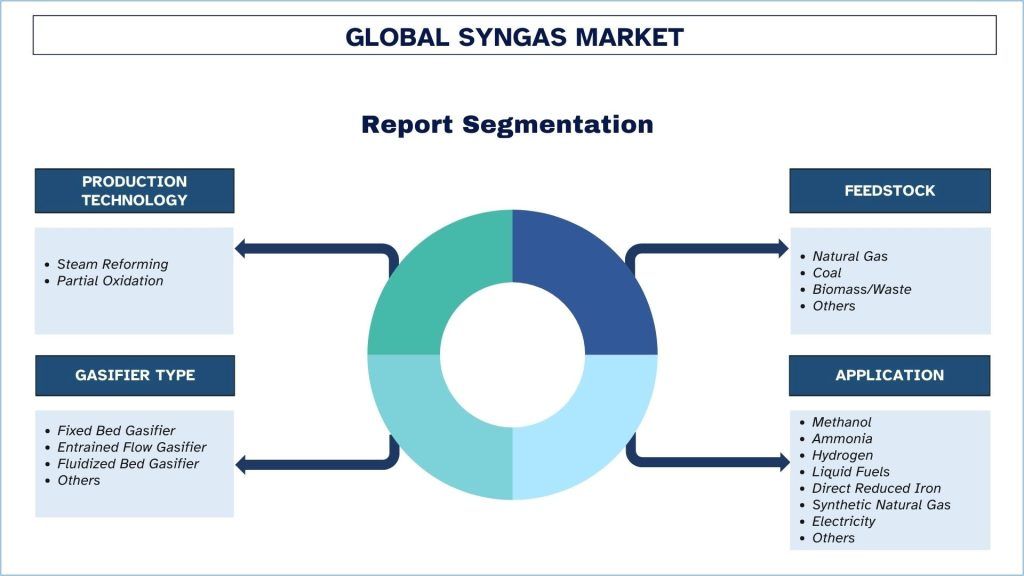
Oczekuje się, że region Azji i Pacyfiku będzie rósł ze znacznym CAGR w okresie prognozy
Region Azji i Pacyfiku w znacznym stopniu przyczynił się do rozwoju rynku syngazu. Wynika to głównie z wysokiego tempa industrializacji, rosnącego zużycia energii w regionie oraz silnego nacisku przemysłu na produkcję chemikaliów. Chiny i Indie przodują ze względu na przemysł chemiczny i rosnące potrzeby w zakresie wytwarzania energii. Spośród krajów Chiny mają największy udział w rynku syngazu ze względu na obfitość węgla i plan rządu dotyczący mniejszego polegania na importowanym gazie ziemnym i ropie naftowej. Ponadto nacisk na rozwój czystej produkcji energii w regionie oraz produkcja wodoru za pomocą syngazu również napędza globalny rynek. Rosnący trend w industrializacji i zwiększony kapitał zainwestowany w technologie syngazu stawiają region Azji i Pacyfiku w strategicznej pozycji na globalnym rynku syngazu.
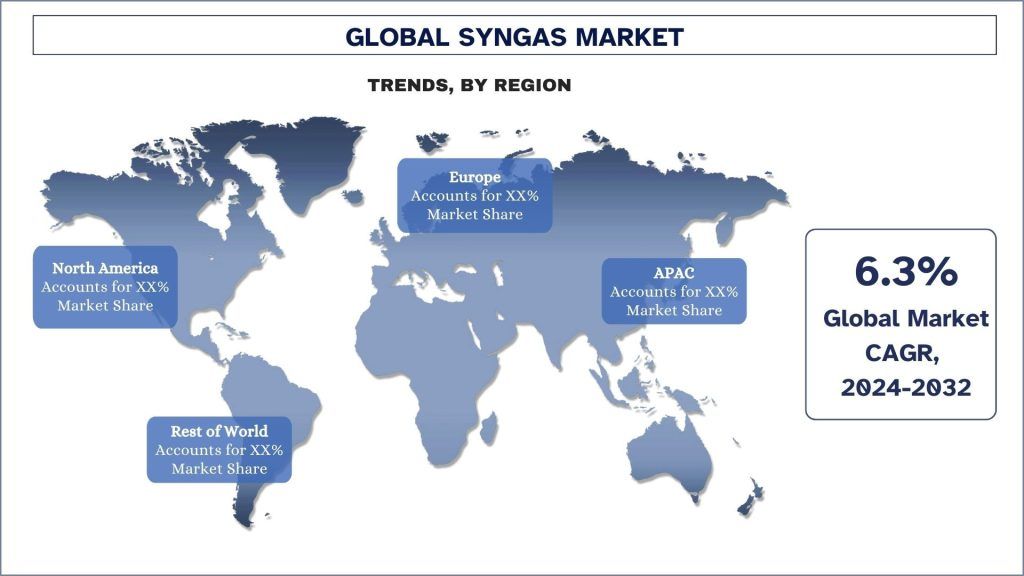
Przegląd branży syngazu
- Rynek syngazu jest konkurencyjny i rozdrobniony, z obecnością kilku globalnych i międzynarodowych graczy rynkowych. Kluczowi gracze przyjmują różne strategie rozwoju, aby wzmocnić swoją obecność na rynku, takie jak partnerstwa, umowy, współpraca, wprowadzanie nowych produktów na rynek, ekspansje geograficzne oraz fuzje i przejęcia. Niektóre z głównych graczy działających na rynku to Siemens AG, Linde Plc, Sasol, Shell Plc, Topsoe AS, Maire Tecnimont Spa, Dow Inc, Technip Energies NV, Air Products and Chemicals Inc i Air Liquide.
Wiadomości z rynku syngazu
- W 2023 roku Linde Engineering podpisało umowę z BASF w Chinach na inżynierię, zaopatrzenie i budowę zakładu gazu syntezowego.
- W 2023 roku Sasol Italy i Sonatrach Raffineria Italiana zamierzają zbudować innowacyjny zakład o znacznych zdolnościach produkcyjnych w zakresie produkcji wodoru i syngazu o niskiej emisji dwutlenku węgla. Zakład będzie w stanie wychwytywać i ponownie wykorzystywać CO2 i przyczyni się do procesu dekarbonizacji obu zakładów.
Zakres raportu o rynku syngazu
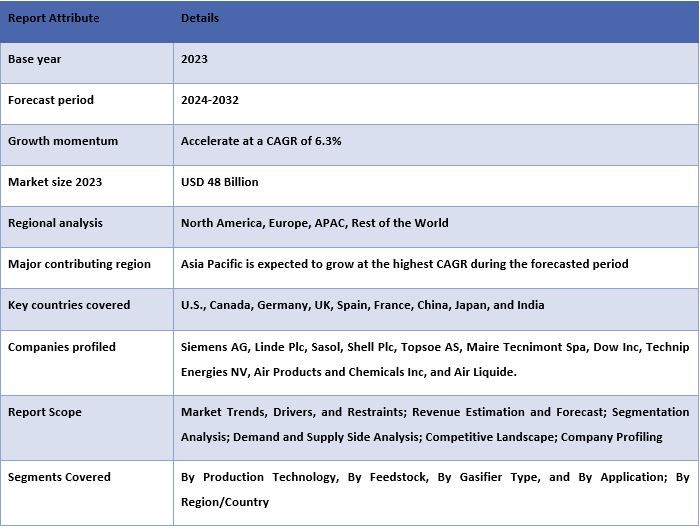
Powody, dla których warto kupić ten raport:
- Badanie obejmuje analizę wielkości rynku i prognoz zweryfikowaną przez uwierzytelnionych kluczowych ekspertów branżowych.
- Raport przedstawia szybki przegląd ogólnej kondycji branży w jednym miejscu.
- Raport obejmuje dogłębną analizę wybitnych konkurentów w branży, z głównym naciskiem na kluczowe dane finansowe, portfele produktów, strategie ekspansji i najnowsze osiągnięcia.
- Szczegółowe badanie czynników napędzających, ograniczeń, kluczowych trendów i możliwości występujących w branży.
- Badanie kompleksowo obejmuje rynek w różnych segmentach.
- Dogłębna analiza branży na poziomie regionalnym.
Opcje dostosowania:
Globalny rynek syngazu można dodatkowo dostosować do wymagań lub dowolnego innego segmentu rynku. Oprócz tego UMI rozumie, że możesz mieć własne potrzeby biznesowe, dlatego zachęcamy do kontaktu z nami, aby uzyskać raport, który w pełni odpowiada Twoim wymaganiom.
Spis treści
Metodologia badań rynku gazu syntezowego (2024-2032)
Analiza historycznego rynku, szacowanie obecnego rynku i prognozowanie przyszłego rynku globalnego gazu syntezowego to trzy główne kroki podjęte w celu stworzenia i analizy adopcji gazu syntezowego w głównych regionach na całym świecie. Przeprowadzono wyczerpujące badania wtórne w celu zebrania historycznych danych rynkowych i oszacowania obecnej wielkości rynku. Po drugie, aby zweryfikować te spostrzeżenia, wzięto pod uwagę liczne ustalenia i założenia. Ponadto przeprowadzono również wyczerpujące wywiady pierwotne z ekspertami branżowymi w całym łańcuchu wartości globalnego rynku gazu syntezowego. Po założeniu i walidacji danych rynkowych poprzez wywiady pierwotne, zastosowaliśmy podejście odgórne/oddolne w celu prognozowania całkowitej wielkości rynku. Następnie zastosowano metody podziału rynku i triangulacji danych, aby oszacować i przeanalizować wielkość rynku segmentów i podsegmentów branży. Szczegółowa metodologia została wyjaśniona poniżej:
Analiza historycznej wielkości rynku
Krok 1: Dogłębne badanie źródeł wtórnych:
Przeprowadzono szczegółowe badania wtórne w celu uzyskania historycznej wielkości rynku gazu syntezowego poprzez wewnętrzne źródła firmy, takie jak raporty roczne i sprawozdania finansowe, prezentacje wyników, komunikaty prasowe itp., oraz źródła zewnętrzne, w tym czasopisma, wiadomości i artykuły, publikacje rządowe, publikacje konkurencji, raporty sektorowe, bazy danych stron trzecich i inne wiarygodne publikacje.
Krok 2: Segmentacja rynku:
Po uzyskaniu historycznej wielkości rynku gazu syntezowego przeprowadziliśmy szczegółową analizę wtórną w celu zebrania historycznych spostrzeżeń rynkowych i udziałów dla różnych segmentów i podsegmentów dla głównych regionów. Główne segmenty zawarte w raporcie to technologia produkcji, surowiec, typ gazogeneratora, zastosowanie i region. Przeprowadzono dalsze analizy na poziomie krajów, aby ocenić ogólne przyjęcie modeli testowych w danym regionie.
Krok 3: Analiza czynnikowa:
Po uzyskaniu historycznej wielkości rynku różnych segmentów i podsegmentów przeprowadziliśmy szczegółową analizę czynnikową w celu oszacowania obecnej wielkości rynku gazu syntezowego. Ponadto przeprowadziliśmy analizę czynnikową przy użyciu zmiennych zależnych i niezależnych, takich jak technologia produkcji, surowiec, typ gazogeneratora i zastosowanie gazu syntezowego. Przeprowadzono dokładną analizę scenariuszy popytu i podaży, biorąc pod uwagę najważniejsze partnerstwa, fuzje i przejęcia, ekspansję biznesową i wprowadzenie produktów na rynek w sektorze gazu syntezowego na całym świecie.
Szacowanie i prognozowanie obecnej wielkości rynku
Określanie obecnej wielkości rynku: Na podstawie praktycznych spostrzeżeń z powyższych 3 kroków doszliśmy do obecnej wielkości rynku, kluczowych graczy na globalnym rynku gazu syntezowego i udziałów w rynku poszczególnych segmentów. Wszystkie wymagane udziały procentowe i podziały rynku zostały określone przy użyciu wspomnianego powyżej podejścia wtórnego i zweryfikowane poprzez wywiady pierwotne.
Szacowanie i prognozowanie: W przypadku szacowania i prognozowania rynku przypisano wagi różnym czynnikom, w tym czynnikom napędzającym i trendom, ograniczeniom i możliwościom dostępnym dla interesariuszy. Po przeanalizowaniu tych czynników zastosowano odpowiednie techniki prognozowania, tj. podejście odgórne/oddolne, aby dojść do prognozy rynkowej na rok 2032 dla różnych segmentów i podsegmentów na głównych rynkach na całym świecie. Metodologia badań przyjęta do oszacowania wielkości rynku obejmuje:
- Wielkość rynku branży, pod względem przychodów (USD) i wskaźnika adopcji gazu syntezowego na głównych rynkach krajowych
- Wszystkie udziały procentowe, podziały i rozbicia segmentów i podsegmentów rynku
- Kluczowi gracze na globalnym rynku gazu syntezowego w zakresie oferowanych produktów. Ponadto strategie wzrostu przyjęte przez tych graczy, aby konkurować na szybko rozwijającym się rynku.
Walidacja wielkości i udziału w rynku
Badania pierwotne: Przeprowadzono dogłębne wywiady z kluczowymi liderami opinii (KOL), w tym kadrą kierowniczą najwyższego szczebla (CXO/VP, szef sprzedaży, szef marketingu, szef operacyjny, szef regionalny, szef krajowy itp.) w głównych regionach. Następnie podsumowano wyniki badań pierwotnych i przeprowadzono analizę statystyczną, aby udowodnić postawioną hipotezę. Dane wejściowe z badań pierwotnych zostały skonsolidowane z wynikami wtórnymi, przekształcając w ten sposób informacje w praktyczne spostrzeżenia.
Podział uczestników pierwotnych w różnych regionach
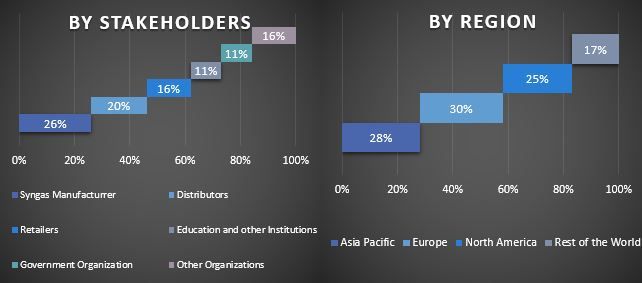
Inżynieria rynku
Zastosowano technikę triangulacji danych, aby ukończyć ogólne szacowanie rynku i dojść do precyzyjnych danych statystycznych dla każdego segmentu i podsegmentu globalnego rynku gazu syntezowego. Dane podzielono na kilka segmentów i podsegmentów po przestudiowaniu różnych parametrów i trendów w obszarach technologii produkcji, surowca, typu gazogeneratora i zastosowania na globalnym rynku gazu syntezowego.
Główny cel globalnego badania rynku gazu syntezowego
W badaniu wskazano obecne i przyszłe trendy rynkowe na globalnym rynku gazu syntezowego. Inwestorzy mogą uzyskać strategiczne spostrzeżenia, na których mogą oprzeć swoje decyzje dotyczące inwestycji na podstawie analizy jakościowej i ilościowej przeprowadzonej w badaniu. Obecne i przyszłe trendy rynkowe określiły ogólną atrakcyjność rynku na poziomie regionalnym, zapewniając uczestnikom branżowym platformę do wykorzystania niewykorzystanego rynku w celu skorzystania z przewagi pioniera. Inne ilościowe cele badań obejmują:
- Analiza obecnej i prognozowanej wielkości rynku gazu syntezowego pod względem wartości (USD). Ponadto analiza obecnej i prognozowanej wielkości rynku różnych segmentów i podsegmentów.
- Segmenty w badaniu obejmują obszary technologii produkcji, surowca, typu gazogeneratora i zastosowania.
- Zdefiniowanie i analiza ram regulacyjnych dla gazu syntezowego
- Analiza łańcucha wartości związanego z obecnością różnych pośredników, wraz z analizą zachowań klientów i konkurentów w branży.
- Analiza obecnej i prognozowanej wielkości rynku gazu syntezowego dla głównego regionu.
- Główne kraje regionów badanych w raporcie to Azja i Pacyfik, Europa, Ameryka Północna i reszta świata
- Profil firmy na rynku gazu syntezowego oraz strategie wzrostu przyjęte przez uczestników rynku w celu utrzymania się na szybko rozwijającym się rynku.
- Dogłębna analiza branży na poziomie regionalnym
Najczęściej zadawane pytania FAQ
P1: Jaka jest obecna wielkość rynku i potencjał wzrostu rynku syngazu?
Pytanie 2: Jakie są czynniki napędzające wzrost rynku syngazu?
P3: Który segment ma największy udział w rynku Syngazu pod względem Technologii Produkcji?
P4: Jakie są nowe technologie i trendy na rynku gazu syntezowego?
P5: Który region zdominuje rynek gazu syntezowego?
Powiązane Raporty
Klienci, którzy kupili ten przedmiot, kupili również

